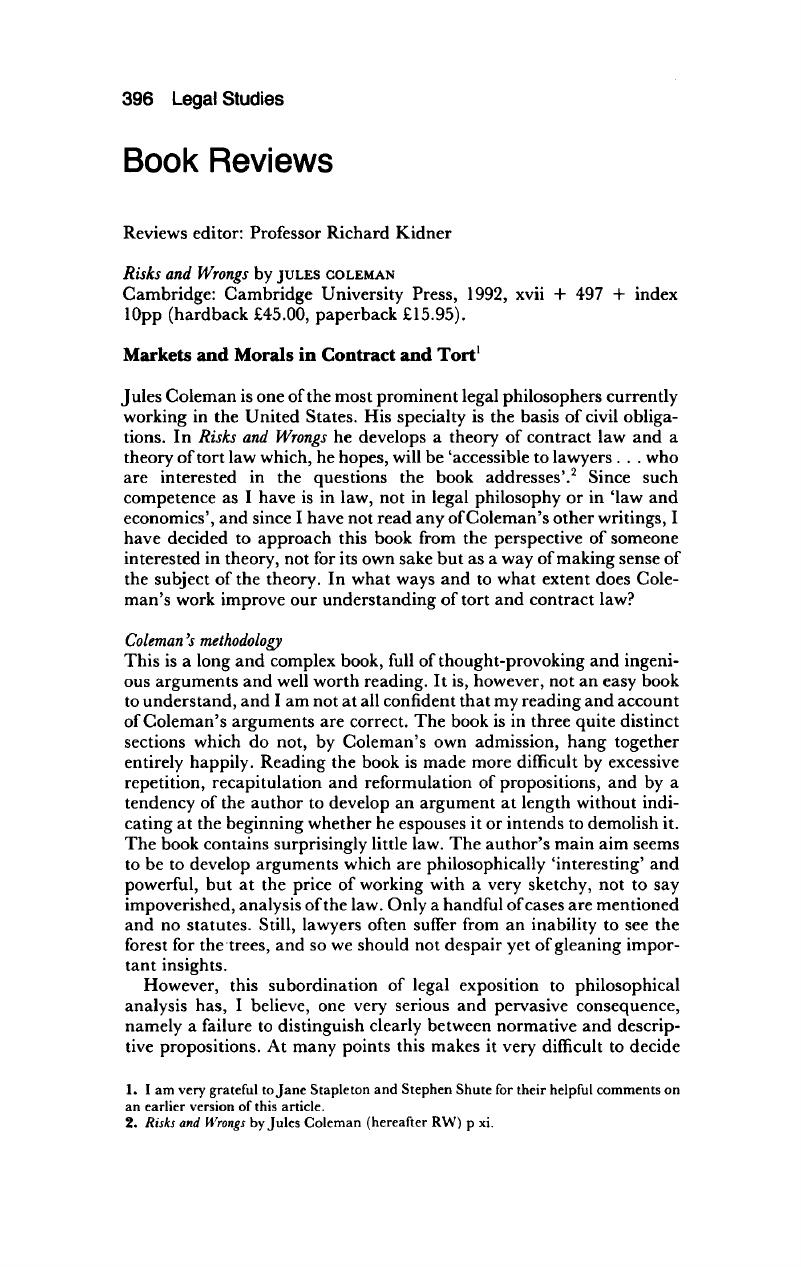Published online by Cambridge University Press: 02 January 2018

1 I am very grateful to Jane Stapleton and Stephen Shute for their helpful comments on an earlier version of this article.
2 Risks and Wrongs by Jules Coleman (hereafter RW) p xi.
3 RW p 7.
4 But see RW pp 8, 479, n 1 and 490–1, n 1.
5 For the idea of ‘explanation’ see RW pp 7–8.
6 RW pp8–11.
7 RW p 7.
8 RW p 10.
9 See Cane in P Cane and J Stapleton Essays for Patrick Atiyah (Oxford, 1991) pp 352—3.
10 Stephen Shute pointed out to me that HLA Hart draws a similar distinction in his analysis of punishment: Punishment and Responsibility (Oxford, 1968) ch 1.
11 Cane, op cit n 9 above, p 355.
12 RW p2.
13 I shall refer to this as the ‘efficiency theory of law’.
14 RW p 17.
15 RW p 67.
16 See esp. RW pp 5 M 5.
17 See RW pp 91–8.
18 London, 1986.
19 See RW pp 53–9, 111—117, 121, 138—9, 143, 180—2.
20 RW p 192.
21 RW p 73.
22 RW p 186.
23 RW p 188.
24 RW p 190.
25 RW pp 345, 428.
26 See Cane Tort Law and Economic Interests (Oxford, 1991), p 466.
27 RW ch 10.
28 RW p 197.
29 RW p 198.
30 Ibid.
31 RW p 387.
32 In criminal law, where the burden of proof is ‘beyond reasonable doubt’, the problem is quantitatively, but not qualitatively, different.
33 Coleman's response to this fact bears on the descriptive normative confusion noted earlier: ‘we will have to be careful not to infer too much about the substantive goals of tort law from an examination of the cases’: RW p 395. How can a theory which cannot cope with primary legal materials claim to be the best interpretation of tort law (or, indeed, of any branch of law)?
34 RW p 493, n 7.
35 RW pp 205–9.
36 RW 208.
37 RW pp 288–90, 369–71.
38 RW p 492, n 8.
39 RW p 198.
40 But see RW p 481, n 5. Also, we know from his discussion of market share liability that he does not treat wrongful imposition of risk as ‘loss’.
41 RW pp 290–1, 424—8.
42 RW pp 221 (emphasis added).
43 RW p 225 (emphasis added).
44 It might be argued that the victim is always at least a but-for cause of the injury. But Coleman rejects but-for as an adequate test of causation and seeks, instead, ‘an account of causation that can provide reasons of some weight for imposing liability’ (RW p 271).
45 It should also be noted incidentally that Coleman's discussion of the standard of liability is greatly handicapped by the admitted (RW pp 215-16) lack of consideration of contributory negligence in general and apportionment in particular. The defence of assumption of risk makes no appearance.
46 RW p299.
47 RW p 284.
48 RW p 326.
49 Ibid.
50 RW p 274.
51 RW pp 274—5.
52 RW p 470.
53 RW p 470.
54 RW pp 345–7.
55 But see RW pp 469–71, n 8.
56 RW p 330.
57 RW pp 333–4.
58 RW p 331.
59 Nor does he offer any theory of what constitutes tortious ‘wrongdoing’. But see RW pp 348—54 for some preliminary thoughts.
60 RW pp 374–80.
61 RW p 380.
64 RW p 188.
63 RW p 419.
64 RW p 495, n 7.
65 RW p 418; see also p 496, n 11
66 RW pp 437-8.